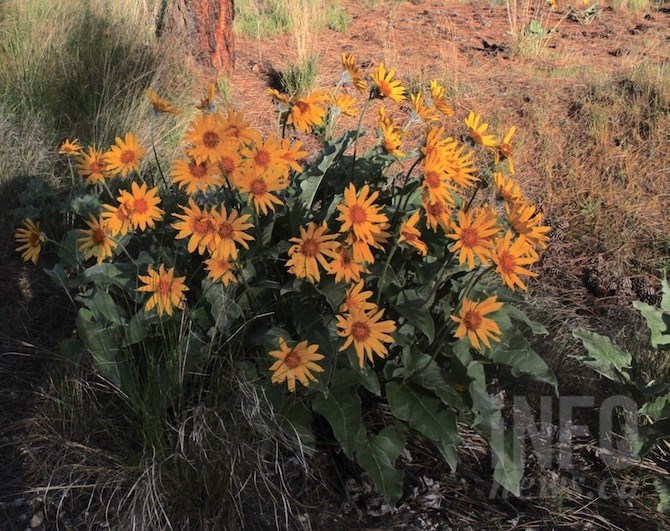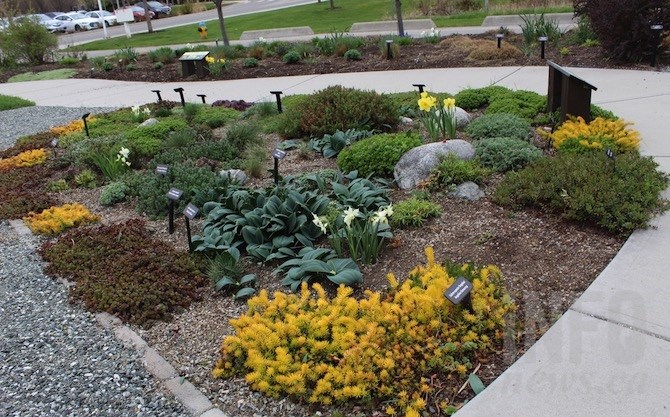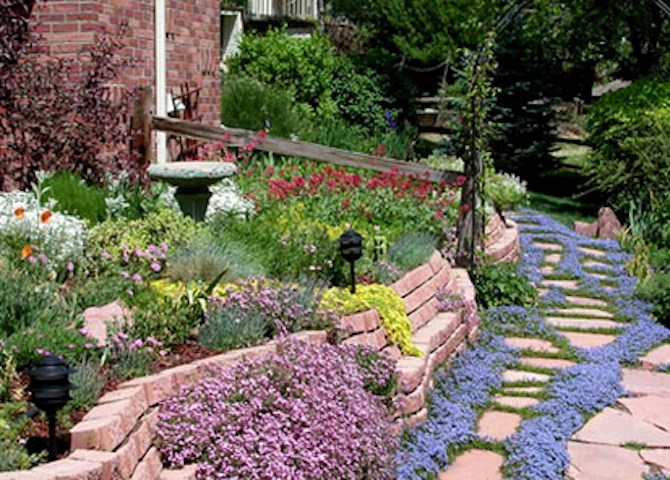
The Okanagan Sunflower (arrowleaf balsamroot) is an example of a native plant that is drought tolerant and blooming right now in the Okanagan.
(ROB MUNRO / iNFOnews.ca)
May 09, 2019 - 2:48 PM
KELOWNA - Looking around at Okanagan gardens it’s obvious that they stretch to two extremes that are not suited to the region’s long dry summers.
On one extreme are lawns with cedar tree screening that gobble up increasingly scarce water. At the other, is the zeroscaping approach that covers yards in concrete and gravel in an effort to not use any water at all.
Neither extreme is what the Okanagan climate is all about, according to Eva Antonijevic, the community programs director for the Okanagan Xeriscaping Association.
“Here in the Okanagan we are semi-arid," Antonijevic told iNFOnews.ca. “We do have vegetation. We don’t just have bare landscape. We have plants that are highly adapted to the conditions, so the roots systems are really deep."
One example of a native water resistant plant is what is commonly known as the Okanagan Sunflower (arrowleaf balsamroot) that is blooming now. It has bright yellow flowers in the spring and is totally edible. It also has roots that are two metres deep so it can survive the dry summers.
Unfortunately, that means some are being destroyed as people try to dig them out. They can only be grown from seed, Antonijevic said.

The xeriscape demonstration garden at the H2O Fitness and Adventure Centre in Kelowna.
(ROB MUNRO / iNFOnews.ca)
Xeriscaping is really about growing plants that suit their environment.
That doesn’t mean only growing native plants, Antonijevic said. It means researching what plants need before you buy them, grouping plants together with similar water needs and seeking out hardy alternatives to things like cedars that just suck up the water or die.
There are principles of xeriscape that can help gardeners become more water wise, like having lawns for children to play on, but to look at grass types that need less water, and letting the grass dry out so the roots reach deeper into the soil to get water.
It also means watering wisely. Any plant needs plenty of water for its first year or two. After that, its roots can reach deeper, although some watering is usually needed.
Vitally important is having good, deep soil for a lawn. The soil should be at least 30 centimetres deep.
“At the end it’s all about soil,” Antonijevic said. “I heard a phrase before: you should plant a $5 tree into a $15 hole. I think that should apply to everything. If you have a good foundation in your garden things grow.”

This photo shows a large xeriscape garden in Denver, Colorado, where the term originated in the 1980s.
Image Credit: Xeriscape Colorado
For those who want annual plants that need more water, she suggests planting them in pots near your house where you can see when they need watering.
There is a small xeriscape garden at the H2O Fitness and Adventure Centre in Kelowna. Each year the plants are divided and sold to the public (that happened last weekend) with the unsold items going back into the garden.
Antonijevic is hoping to create a hedge of native shrubs to show what can be done to create water wise privacy screens in the summer.
There is also what may be the largest xeriscape garden in Canada at the Summerland Research and Development Centre, but Antonijevic said it needs some more volunteer help.
So, if it’s not zeroscaping, why is it called xeriscaping.
The term was coined in Denver, Colorado in the early 1980s, Antonijevic said, explaining that 'xeri' means dry and 'scape' means vista, so dry land.
“It was purely for gardening with less water,” she said. “(The name) kind of got stuck. I feel we should be using 'water wise landscape' instead. (Xeriscape) gives this false image that it means no landscaping.”
The Okanagan Xeriscaping Association website has a data base of 400 plants that can be searched.
Antonijevic is one of the three principal authors of Building Climate Resilience in the Okanagan – A Homeowner’s Resource Guide. It was published this year by the South Okanagan Real Estate Board and is available online here.
To contact a reporter for this story, email Rob Munro or call 250-808-0143 or email the editor. You can also submit photos, videos or news tips to the newsroom and be entered to win a monthly prize draw.
We welcome your comments and opinions on our stories but play nice. We won't censor or delete comments unless they contain off-topic statements or links, unnecessary vulgarity, false facts, spam or obviously fake profiles. If you have any concerns about what you see in comments, email the editor in the link above.
News from © iNFOnews, 2019